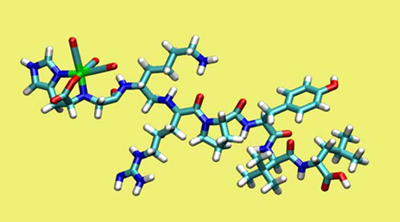| Name
|
Neurotensin
|
| Other Name
|
|
| Sequence (Single letter abbreviations)
|
Pyr-LYENKPRRPYIL
|
| Sequence(Three letter abbreviations)
|
{PYR}{LEU}{TYR}{GLU}{ASN}{LYS}{PRO}{ARG}{ARG}{PRO}{TYR}{ILE}{LEU}
|
| Basic description
|
Neurotensin is a brain and gastrointestinal peptide that fulfils many central and peripheral functions through its interaction with specific receptors. Three subtypes of neurotensin receptors have been cloned. Two of them belong to the family of G protein-coupled receptors, whereas the third one is an entirely new type of neuropeptide receptor and is identical to gp95/sortilin, a 100,000 Da-protein with a single transmembrane domain. Neurotensin isolated primarily from the nervous system of the hypothalamus, median eminence, substantia nigra and brain stem, has many neurotransmitter-like characteristics. Neurotensin can lower blood pressure, increase vascular permeability and increase plasma levels of glucagon, glucose, growth hormone, and prolactin in rats.
|
| Solubility
|
Soluble in water
|
| The molecular weight
|
1671.920
|
| Chemical formula
|
C78H121N21O20
|
| The purity
|
> 95%
|
| Storage conditions
|
Storage at -20°C. Keep tightly closed.
|
| Annotation
|
Neurotransmitter-like hypothalamic peptide that lowers blood pressure, increases vascular permeability, and increases blood levels of glucagon, glucose, growth hormone, and prolactin in rats.
|
| Documents
|

|
| Figures
|

|
| Reference
|
Donelan J, et al. Corticotropin-releasing hormone induces skin vascular permeability through a neurotensin-dependent process. Proc. Natl. Acad. Sci. USA. May 2006; 103(20): 7759-7764.
Eriste E, et al. A novel form of neurotensin post-translationally modified by arginylation. J. Biol. Chem. Oct 2005; 280(42): 35089-35097.
Souaze F, et al. Neurotensin receptor 1 gene activation by the Tcf/beta-catenin pathway is an early event in human colonic adenomas. Carcinogenesis. Apr 2006; 27(4): 708-716.
|
